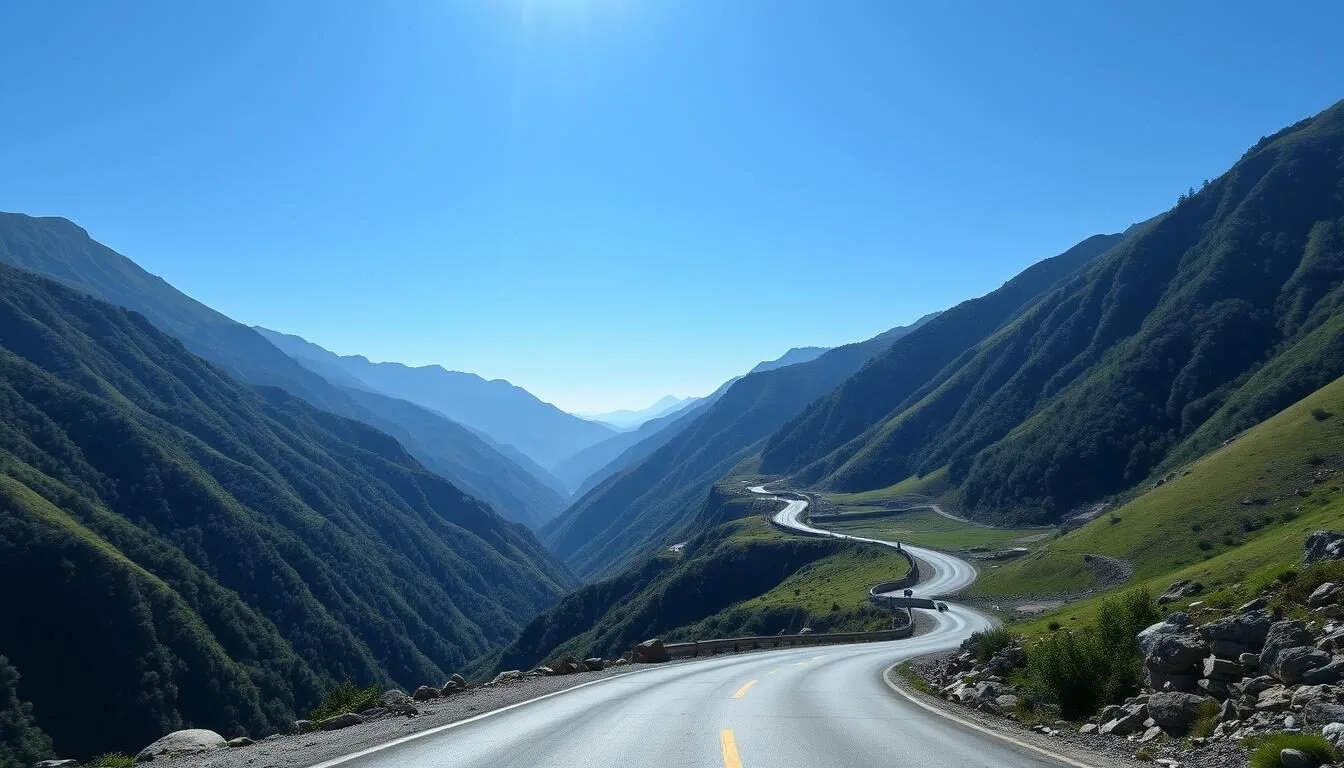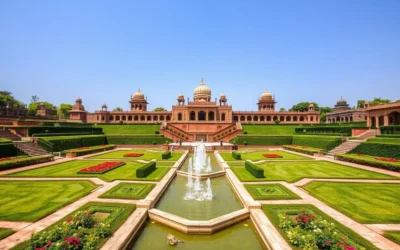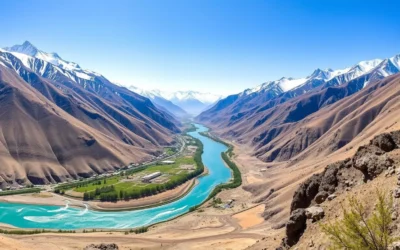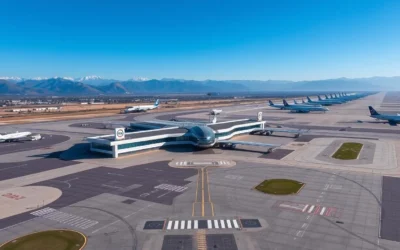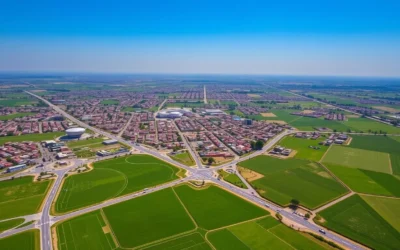✓ Accommodations✓ Flights✓ Rental Cars
Nestled in the majestic Himalayas at elevations ranging from 2,134 to 13,690 feet, Kaghan Valley is home to Pakistan’s emerald jewel, Lake Saif-ul-Malook, which sits at an astonishing 10,578 feet above sea level, making it one of the highest alpine lakes in the country. This breathtaking valley in Khyber Pakhtunkhwa province stretches approximately 160 kilometers, offering visitors a paradise of snow-capped peaks, crystal-clear lakes, and dense pine forests that transform with each season.
Getting to Kaghan Valley
The journey to Kaghan Valley is an adventure in itself, with the total distance from Islamabad being approximately 261 km (162 miles), taking about 5 hours by road. Most travelers begin their journey from Islamabad, following a well-established route through high-speed motorways and mountain roads.
The scenic route to Kaghan Valley offers breathtaking mountain views
Route from Islamabad to Kaghan Valley
| Route Segment | Distance | Travel Time |
| Islamabad to M1 Motorway | 21 km (13 miles) | 23 minutes |
| M1 to M15 (Hazara Motorway) | 56 km (35 miles) | 23 minutes |
| M15 to N15 (National Highway) | 112 km (70 miles) | 1 hour 30 minutes |
| N15 Mansehra to Kaghan | 88 km (55 miles) | 2 hours 45 minutes |
| Kaghan to Naran | 23 km (14.3 miles) | 35 minutes |
For international travelers, the most convenient option is to fly into Islamabad International Airport and then continue by road. Looking for the best flight deals? in advance, especially during peak tourist season when prices tend to rise.
Transportation Options
Public Transport
- Buses to Mansehra depart from Pir Wadhai bus stand in Rawalpindi
- From Mansehra, direct van services operate to Balakot, Kaghan, and Naran
- Local minibuses connect towns within the valley
Private Transport
- Jeep rentals available in Balakot, Kewai, Shogran, Kaghan, and Naran
- Private car hire from Islamabad (recommended for comfort)
- Rental cars available for self-driving adventures
Best Time to Visit Kaghan Valley
Timing your visit to Kaghan Valley is crucial for the best experience. The valley experiences distinct seasons, each offering a unique perspective on its natural beauty.

Summer brings lush greenery and perfect hiking conditions to Kaghan Valley
Summer (May-September)
The ideal time to visit when the weather is mild and roads are fully accessible. Temperatures range from 15°C to 25°C (59°F to 77°F), perfect for outdoor activities. The valley bursts into lush greenery, wildflowers bloom, and all tourist facilities are operational.
Recommended
Winter (December-February)
For snow enthusiasts, winter transforms the valley into a magical wonderland. Temperatures drop below freezing, and heavy snowfall creates stunning landscapes. Note that many roads may be closed, and access is limited to lower elevations of the valley.
Limited Access
Spring/Autumn (April & October)
Shoulder seasons offer fewer crowds and moderate weather. Spring brings blooming flowers while autumn showcases golden hues. Temperatures are cooler (10°C to 20°C), and some high-altitude attractions may still be inaccessible in early spring.
Less Crowded
Ready to experience Kaghan Valley’s natural beauty?
Plan your trip during the perfect season and secure the best accommodations.
Top Attractions in Kaghan Valley
Kaghan Valley boasts numerous natural wonders that captivate visitors with their pristine beauty. From crystal-clear lakes to panoramic mountain passes, here are the must-visit attractions that should be on every traveler’s itinerary.
Lake Saif-ul-Malook

The legendary Lake Saif-ul-Malook, one of Pakistan’s most photographed natural wonders
Considered the fifth-best tourist destination in Pakistan, Lake Saif-ul-Malook sits at an elevation of 10,578 feet (3,224 meters) above sea level. This alpine lake is renowned for its crystal-clear waters that reflect the majestic Malika Parbat, the highest peak in the Kaghan Valley. The lake is accessible via a 30-minute jeep ride from Naran or a challenging 3-hour trek.
Visitors can enjoy boating on the lake during daytime and camping under the stars at night. The lake is also home to brown trout, making it a popular spot for fishing enthusiasts. For guided tours to this magical lake, book with our trusted partner.
Lulusar Lake

Lulusar Lake, the main source of the Kunhar River flowing through Kaghan Valley
Located about 50 km from Naran at an elevation of 11,190 feet (3,410 meters), Lulusar Lake is the primary source of the Kunhar River. The lake is surrounded by snow-capped peaks, creating a breathtaking panorama that’s particularly stunning in summer when the surrounding area turns lush green.
The road to Lulusar is well-maintained, making it accessible by regular vehicles. Wildlife enthusiasts might spot local fauna like foxes, black bears, and Himalayan snowcocks in the surrounding Lulusar-Dudipatsar National Park.
Babusar Top

Babusar Top offers breathtaking panoramic views at 13,700 feet above sea level
At an impressive altitude of 13,700 feet (4,173 meters), Babusar Top is the highest point in Kaghan Valley accessible by vehicle. This mountain pass connects Khyber Pakhtunkhwa province with Gilgit-Baltistan region and offers some of the most spectacular panoramic views in northern Pakistan.
The journey to Babusar Top is an adventure in itself, with winding roads and dramatic changes in landscape. Visitors should bring warm clothing as temperatures can drop significantly even in summer due to the high elevation.
Ansoo Lake
Named for its tear-like shape (“Ansoo” means tear in Urdu), this hidden gem requires a challenging trek from Lake Saif-ul-Malook. Sitting at 14,039 feet (4,250 meters), the lake is often shrouded in mist, adding to its mystical appeal. The best time to visit is between June and August when the trail is clear of snow.
Lalazar Meadows
These lush green meadows near Batakundi village offer a perfect retreat into nature. Surrounded by pine and fir forests with views of the snow-covered Falak-Sar peak, Lalazar is accessible via a thrilling jeep ride through mountain tracks. The meadows are particularly beautiful when wildflowers bloom in summer.

The picturesque Lalazar Meadows offer a perfect retreat into nature
Things to Do in Kaghan Valley
Beyond sightseeing, Kaghan Valley offers numerous activities for adventure seekers and nature lovers alike. Here are some of the best experiences to add to your itinerary.
Trekking & Hiking
The valley offers numerous trekking routes for all skill levels. Popular trails include the trek to Ansoo Lake from Saif-ul-Malook (7-9 hours round trip), the hike to Dudipatsar Lake (4-5 hours), and shorter nature walks around Naran and Shogran.
Book a Guided Trek
Fishing
The Kunhar River and Lake Saif-ul-Malook are famous for brown and rainbow trout fishing. Licenses can be obtained from the Fisheries Department in Naran or Shinu. Fishing equipment can be rented at Naran Bazaar for those who don’t bring their own gear.
Jeep Adventures
Explore remote areas of the valley with thrilling jeep rides to destinations like Siri Paye Meadows, Lalazar, and Babusar Top. These journeys offer access to spectacular viewpoints that can’t be reached by regular vehicles.

Jeep adventures offer access to remote areas and spectacular viewpoints in Kaghan Valley
Camping
Experience the valley’s natural beauty up close by camping at designated sites near Lake Saif-ul-Malook, Lalazar Meadows, or Siri Paye. The stargazing opportunities are exceptional due to minimal light pollution in these remote areas.
Photography
With its diverse landscapes, Kaghan Valley is a photographer’s paradise. Dawn and dusk offer magical lighting conditions at lakes and mountain viewpoints. The changing seasons provide varied photography opportunities throughout the year.
Boating
Enjoy peaceful boat rides on Lake Saif-ul-Malook and Lulusar Lake during summer months. The crystal-clear waters reflect the surrounding mountains, creating perfect photo opportunities and a serene experience.
Where to Stay in Kaghan Valley
Kaghan Valley offers a range of accommodation options to suit different budgets and preferences. Most visitors base themselves in either Naran or Kaghan town, though options are also available in smaller settlements like Shogran and Balakot.

Traditional wooden lodges offer a cozy stay experience in Kaghan Valley
Naran
The main tourist hub with the widest range of accommodations from budget guesthouses to mid-range hotels. Facilities are better developed here, with reliable electricity and mobile connectivity. Most hotels operate from May to September only.
- Pine Park Hotel
- Hotel One Naran
- Troutland Hotel & Restaurant
Kaghan
A quieter alternative to Naran with more affordable lodging options. The town offers a more authentic local experience with fewer tourists. Accommodations range from simple guesthouses to modest hotels.
- Kaghan Hotel
- Pine View Hotel
- River View Inn
Shogran
A picturesque hill station with several good quality hotels and resorts. Located at 7,749 feet (2,362 meters), it offers cooler temperatures and spectacular views of Makra Peak and the surrounding forests.
- Pine Park Resort Shogran
- Lalazar Hotel
- Hilltop Hotel
During peak season (June-August), accommodations fill up quickly, so it’s advisable to book your stay well in advance. Many hotels in the region don’t maintain online booking systems, so calling directly or booking through a local travel agent is often necessary.
Camping Options
For the adventurous traveler, camping is a popular alternative to traditional accommodations. Designated camping sites are available near Lake Saif-ul-Malook, Lalazar Meadows, and Siri Paye. Some sites offer tent rentals and basic facilities, while others are more primitive. Always camp responsibly and follow leave-no-trace principles.
Practical Information
Planning a trip to Kaghan Valley requires some preparation, especially regarding local facilities, weather conditions, and cultural considerations. Here’s what you need to know before you go.

Local markets in Naran offer souvenirs, crafts, and essential supplies
Local Facilities
- ATMs and banking services are available in Naran but may be limited in smaller towns
- Mobile network coverage is generally good in main towns but can be spotty in remote areas
- Medical facilities are basic; bring any necessary medications and a first-aid kit
- Petrol stations are available in major towns; fill up before heading to remote areas
- Shops in Naran and Kaghan sell basic supplies, souvenirs, and local crafts
Weather & Packing
- Weather can change rapidly; pack layers even in summer
- Sturdy walking shoes or hiking boots are essential
- Sunscreen, sunglasses, and hats are necessary due to high altitude
- Warm clothing is required for evenings, even in summer
- Waterproof gear is recommended, especially during monsoon season (July-August)
Local Cuisine
Kaghan Valley offers a taste of authentic Pakistani and Pashtun cuisine. Don’t miss trying the following local specialties:

Fresh trout from the Kunhar River is a local delicacy in Kaghan Valley
Trout Fish
Freshly caught from the Kunhar River and local lakes, trout is typically grilled or fried and served with local spices. Many restaurants in Naran specialize in this local delicacy.
Chapli Kebab
A popular Pashtun dish made from minced meat mixed with spices and formed into flat patties. These flavorful kebabs are a must-try at local eateries throughout the valley.
Traditional Tea
Locals enjoy green tea and “noon chai” (pink tea with salt), especially in cooler weather. Tea stalls are common throughout the valley, offering a perfect way to warm up while enjoying mountain views.
Safety Tips
- Check weather forecasts before traveling, especially in winter or monsoon seasons
- Inform someone about your itinerary when trekking to remote areas
- Carry sufficient water and snacks when exploring
- Drive cautiously on mountain roads, particularly after rainfall
- Respect local customs and dress modestly, especially in rural areas
- Purchase travel insurance that covers adventure activities and high-altitude trekking
Experience the Magic of Kaghan Valley
From the crystal-clear waters of Lake Saif-ul-Malook to the panoramic vistas of Babusar Top, Kaghan Valley offers a perfect blend of natural beauty, adventure, and cultural experiences. Whether you’re trekking through alpine meadows, fishing for trout in the Kunhar River, or simply soaking in the majestic mountain views, this hidden gem in northern Pakistan promises memories that will last a lifetime.

The magical sunset views of Kaghan Valley will leave you speechless
The best adventures begin with proper planning. Start your journey to this Himalayan paradise today by booking your transportation and accommodations in advance, especially if you’re visiting during the popular summer months.
Ready to explore Kaghan Valley?
Start planning your perfect Pakistani adventure now!
—
The above is subject to change.
Check back often to TRAVEL.COM for the latest travel tips and deals.
